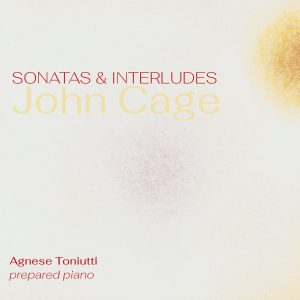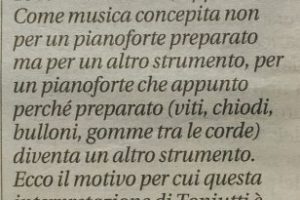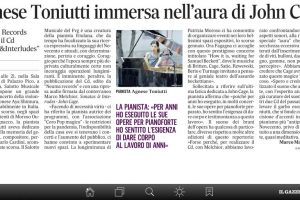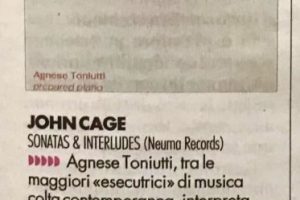New release 2023
Sonatas and Interludes for prepared piano – John Cage
by Neuma Records (2023)
On line purchase
Physical copy and digital download on
Bandcamp and Neuma Records (from March, 17th)
More info in News
REVIEWS (last update June 2023):
Best Bandcamp Contemporary Classical – March 2023
Indeed, holding up this recording against interpretations by John Tilbury, James Tenney, or Herbert Henck reveals subtle, gratifying differences. Toniutti dives into the music with a bracing mix of precision and openness, adding valuable new wrinkles and reinforcing the enduring pleasures of the music.
Peter Margasak, Bandcamp Best Contemporary Classical , April 4th, 2023
Screws and erasers – in view of the unbelievably rich sound palette that unfolds, it is hard to believe that these are the only objects that John Cage opposes to the sublime piano as preparation objects. Even Cage himself noted that the sound result of the preparations can vary greatly depending on the instrument. With her version of the opus magnum for prepared piano, composed in 1946-48, the Italian pianist Agnese Toniutti has succeeded in creating an incredibly high-resolution and subtle recording, both in terms of interpretation and sound. Cage certainly did not call the one-movement miniatures, most of which are barely three minutes long, Sonatas and Interludes without a hint of irony. The symmetrically nested 16 sonatas and four interludes follow in their arrangement and form a stringency that continues in the musical text in the form of idiosyncratically angular rhythms and patterns. Toniutti understands how to implement the often mechanical character of the pieces with emphasis (she herself writes in the booklet that she understands it as her role to implement especially the tone durations as precisely as possible) and yet to recognize and emphasize the humanity, even a cantabile gesture, that they contain. Her fine pianistic agogic delivers an authentic and at the same time organical result. A similar dualism is found on the tonal level. The musical text and the preparation go hand in hand.
The preparation evokes the machine-like character, in which the piano mutates into a real sound apparatus through the screws and erasers. On many recordings, the piano is almost unrecognizable behind these drum-like, often wooden sounds. Agnese Toniutti’s preparation takes a different approach and refreshingly does not hide the sound generator; with many notes the piano tones are clearly recognizable. Paradoxical – and ingenious – is the fact that the preparation sounds are not drowned out by this, but can even be experienced all the more intensely. Thus, Toniutti’s piano is uniquely balanced in reproducing the preparations in an exceptionally wide range of colors (the screws are obviously carefully selected and placed) and at the same time combining them with the familiar tones of the concert grand. The keys are always softly struck, even in the most machine-like conditions, despite the considerable dynamic reduction due to the preparation, which – as Toniutti notes in the booklet – often tempts one to play with more weight. The soft attack underpins the tonal fusion of piano tone and preparation sound. The high sound quality of the recording (sound: Marco Melchior) contributes decisively to the tonal brilliance, which portrays the grand piano very directly and yet warmly and spatially. Agnese Toniutti has succeeded in making an excellent recording of the Sonatas and Interludes, in which she coherently and nuancedly balances machine-like and human agogic as well as preparation and piano sound. The sound result is unique.
Jakob Böttcher, Neue Zeitschrift fuer Musik issue 2/2023
Rafael de Acha, All about the Arts , February 27th, 2023
George W.Harris, Jazz Weekly, February 27th, 2023
“The sound of the work has something special, different from many other editions of this repertoire… we have reason to believe that Cage would have appreciated this magical playful “humus.” Needless to note Toniutti’s performing gracefulness, which blends with that precision of accent inescapable in the most “antipianistic” pianism of the 20th century, devoid of emphasis, restored to a welcoming, almost meditative dimension.”
Marco Maria Tosolini, Il Gazzettino, March 8th, 2023
“Agnese Toniutti, among the greatest “performers” of contemporary classical music, interprets to perfection this summa of modern culture, an authentic watershed for twentieth-century expressive research: nineteen short pieces, composed between1946 and 1948, for the so-called “prepared piano,” within which unusual objects are inserted to distort its sonority, which, in turn, in the writing, looks to Erik Satie, to alea, to acoustic-philosophical India. And the pianist, in approaching the instrument, opts for the wonder of intonation and the delicacy of timbre.”
Guido Michelone, Alias – Il Manifesto, March 18th, 2023
Almost all new-music pianists with a predilection for extended and experimental techniques eventually must reckon with John Cage’s Sonatas and Interludes. As it happens, most of this contemporary classic’s numerous recorded versions are excellent, although the fact that no two prepared pianos sound exactly alike makes it difficult to favor one interpretation over another.
Certainly there’s much to admire in the Italian pianist Agnese Toniutti’s centered rhythm, rich palette of dynamic nuances, and her sensitive textural delineation. For example, the bass note strokes in Sonata No. 3 sound more like distant drum beats here, rather than the usual hitting a garbage can lid, effectively anchoring the gentle right-hand flourishes.
The First Interlude’s relaxed lilt contrasts with slightly more propulsive performances such as those of Julie Steinberg (Music and Arts) and Boris Berman (Naxos). Sonata No. 5’s swaying mallet percussion sonorities stand at opposite ends from Margaret Leng Tan’s ferocity and biting overtones, although the imposing brightness of Tan’s piano renders the barcarolle-like No. 12 more majestically than in Toniutti’s softer-grained rendition. It’s also interesting to contrast the shapely melodic droplets Toniutti creates in the “Gemini” combined Sonatas 14 and 15 with Maro Ajemian’s slower and starker interpretation from her world-premiere recording of the cycle.
While the engineering does justice to Toniutti’s nuanced dyanmics, I prefer the warmer resonance and crystalline clarity of the John Tilbury and Yuji Takahashi reference versions. Still, Toniutti unquestionably conveys the music’s roots in dance, as well as Cage’s subtle humor. Her intelligent, well-written booklet notes discuss both the music and the process of getting it ready for performance. Artistic Quality 9“
“Agnese Toniutti’s New Music Vision – This is the most recent recording by Italian pianist Agnese Toniutti. (her third release by my research). It is also the most recent recording of John Cage’s masterful Sonatas and Interludes (1946-8) for prepared piano, a defining work for that unusual instrument. It has been recorded at least 30 times but is rather rarely heard in live performance. […]
Toniutti, a graduate of The Conservatory of Venice, seems to be as much a researcher and activist as she is a widely skilled pianist. While doubtless schooled in the commonly played repertoire for her instrument, she favors new music and music undeservedly neglected in her performances and recordings as well as the commissioning of new works and finding yet unplayed that strike her fancy.
The Sonatas and Interludes, now some 80 years old doesn’t really qualify as “new music” per se nor can it really be called neglected having been recorded 30+ times. In the context of this release this cycle of pieces seems to function much as a new recording of the Goldberg Variations or the late Beethoven Sonatas might function to introduce the skills of a musician whose trajectory was aimed at the conventional recital hall circuit. Toniutti clearly has other plans.
I won’t attempt to compare this most recent interpretation to the other available recordings. I believe this recording does much to validate the music as an essential work in the western canon of art music and to display the estimable understanding and widely skilled competence of the performer whose work is and will continue to embrace new music and advocate for that music to earn an esteemed place in the minds and hearts of listeners and other performers.
This is a very enjoyable recording whether it is to be a collector’s only recording of this music or one that stands most favorably in comparison to previous recordings. If this is to be your first recording of this work or if you simply want to hear another interpretation, you will not be disappointed. This is a wonderful performance.
Pianist Agnese Toniutti previously released a very forward looking recording on Neuma Records. The 2021 release pictured below is a collection of much more recent music. I listened numerous times and didn’t feel I “got it” well enough to say something reasonably intelligent (if not insightful) until this second release. And while I may not fully understand these “subtle matters” I now have a better context.
This collection which I had yet to review represents Toniutti’s understanding and appreciation as well as her apparent mission to expand the experimental repertoire for piano. Here is a fascinating set of composers, each with a unique view of her instrument. Just listen, trust this artist. You’ll be glad you did.
Keep your eyes and ears open for Agnese Toniutti, an advocate for and a master of the avant garde. And to Ms. Toniutti, I greet you at the beginning of a great career.“
Allan J.Cronin, New Music Buff, April 14th, 2023
Agnese Toniutti, a performer of relaxed radicalism, in Sonatas & Interludes (Neuma Records), decides to treat once again the very famous and highly performed series of 16 Sonatas (in one short movement) and 4 Interludes written by John Cage in 1946-’48. She treats it, in fact. As music conceived not for a prepared piano but for another instrument, for a piano that precisely because it is prepared (screws, nails, bolts, rubbers between the strings) becomes another instrument. That is why this interpretation by Toniutti is sensational. We are listening to a Martian instrument; the technologization of the old piano is extreme and detected. Then there is the anti-solemn attitude of this performer who manages to bring to mind the amiability of Cage in the midst of games (also paradoxically evocative of the Baroque) that seem to take place among laboratory machines and not in front of the most matronly and bourgeois of keyboard instruments. Toniutti’s relaxed and never austere radicalism is new music without problems, entirely enjoyable and exchangeable.
Mario Gamba, Alias – Il Manifesto, April 22nd, 2023
In liner notes for her recording of Cage’s Sonatas and Interludes (1946-48), Italian pianist Agnese Toniutti cites two key details about his prepared innovation, first that it was practically motivated, invented as it was to overcome “the lack of space and financial means to hire a percussion ensemble after the commission of dancer Syvilla Fort,” and second that, in Cage’s own words, “the prepared piano is a percussion ensemble under the control of a single player.” That’s the optimal way to broach this hour-long project, one featuring a seasoned performer who’s presented this material in concert many times and is an expert at rendering his material into physical form. Utilizing bolts, nuts, screws, plastic, and rubber materials, Toniutti typically spends two-and-a-half hours readying the piano for performance. Though Cage provided the performer with exacting instructions (the sizes of bolts and screws, for example, specified and the location of their insertion precisely delineated), every piano responds differently to preparation, which makes every performance unique. Familiar piano timbres sometimes emerge alongside clangorous, metallic-sounding noises (see “Sonata XII”), the music in places calling to mind the playfulness associated with a child’s mechanical toy. When those prepared percussive effects combine with meditative moods, the material begins to suggest the hypnotic lilt of a gamelan ensemble performance (e.g., sonatas three, seven, eight, nine, and eleven). There are, among other things, gleeful explorations, meditations (“Sonata VI”), and even jazzy swing (“First Interlude”). It’s easy to be so sidetracked by the prepared component that Cage the composer gets lost in the process, but Toniutti’s stellar readings remind us that these works have musical value far beyond their treatments, something borne out clearly by the closing sixteenth sonata. Moods and rhythms of contrasting kinds assert themselves in the nineteen pieces, even if a general sense of tranquility underscores the work. As the listener becomes ever more acclimatized to the sound produced by the prepared piano, the attention gradually shifts more toward the musical content. Toniutti shows herself to be a model Cage interpreter in not only fastidiously preparing the piano in accordance with his instructions but in responding to his music with sensitivity and humanizing it in her performance.
Textura editorial team, Textura.org, May 2023
Arnold Schoenberg famously said of his sometime student John Cage, “Of course he’s not a composer, but he’s an inventor – of genius.” Perhaps his greatest invention was the so-called “prepared piano”, in which household items such as screws and bolts, erasers and blu-tack are placed directly onto the strings inside a grand piano, so that the notes are transformed into pings and plops, and a single pianist has at her hands a complete percussion instrument. The description of what has to be placed where inside the piano is incredibly precise, but what is fascinating is how different from each other all prepared pianos sound. It is generally a very dry timbre, often compared to the sound of Indonesian gamelan, with pitches so distorted that conventional melody is rarely able to emerge. Cage’s most extended – and most successful – piece for prepared piano is the set of Sonatas and Interludes from 1946-8. Sixteen short, mostly binary-form sonatas are separated by four free-form interludes. The rhythmic structure of the music is constructed with great numerical care: there is a kind of fractal process by which the small-scale durations are projected onto the whole. But this description is deceptive: the music sounds improvisatory and very free, even where it isn’t. There are umpteen previous recordings of the Sonatas and Interludes. Experimental music legend John Tilbury is a bit too urgent for my tastes, and James Tenney, a student of Cage, perhaps a bit too laid back. Agnese Toniutti is pretty much in the sweet spot. The quirky jazziness of Sonata II is just right, as is the processional elegance of III. Towards the end, XIV is minimalism avant la letter, and the decision to run straight into XV makes for a hypnotic run at the end of the sequence. Italian pianist Agnese Toniutti specialises in 20th and 21st century music, and is clearly deeply embedded in the tradition that Cage started. This is a very worthwhile contribution to the discography of a composer more talked about than listened to.
Bernard Hughes, The Art Desk.com, 8th July 2023
...Agnese Toniutti, already the protagonist for the same Neuma Records of a CD of experimental music, successfully takes up the Cagean challenge, giving us an interpretation at once precise and emotional, controlled and personal, of this cornerstone of twentieth-century piano literature (in the “enlarged” sense, that is, subsequent to the acoustic innovations made not only by Cage, but also by Cowell and others). 8/10
Kathodik, Filippo Focosi, 24th July 2023
The inimitable pianist John Cage experimented with foreign objects between the strings of his Steinway to alter the tone, and that creativity is certainly present on his magnus opus, “Sonatas & Interludes”, which is interpreted by Agnese Toniutti here.
“Sonata I” starts the listen with the distinct mood from the keys that is both mysterious and specific to Cage, sometimes firm and other times soft, and “Sonata II” follows with an upbeat and playful nature that’s even a bit dreamy in scope.
Further along, “Sonata VII” follows very unpredictable patterns, and radiates a presence that seems percussive, while “Sonata X” flows with a cinematic, almost sci-fi delivery of highly iconoclastic piano playing.
Close to the end, “Sonata XIII” carries an abstract and subtly experimental demeanor, and “Sonata XVI” exits the listen with meticulous manipulation of space and tension in the curious, exciting finish.
Toniutti brings her strong attention to timbral ideas for this project, and does a great job capturing the innovative and exploratory mind of Cage with this excellent take on his finest work.
Take Effect Review, 1st August 2023

RADIO BROADCASTING AND INTERVIEWS:
#101.1 Friday Night Free-Form – Santa Fe Public Radio (California, US) curated by Marina La Palma
Sonata II, Third Interlude
20 pm, February 24th, 2023
#90.1 WRUV FM Brulington (Vermont, US) – Second Interlude
10.05 am, February 28th, 2023
#90.1 WRUV FM Brulington (Vermont, US) – Sonata I
10.28 am, March 14th, 2023
#Radio Onde Furlane (Udine, IT) Ator ator, interview with Paolo Cantarutti (Furlan/ITA)
March 15th, 2023 Podcast here
Sonatas 1, 5, 18
#Martian Gardens (Massachusset, US) Episode 1143, curated by Max Shea
March 26th, 2023 Podcast here
Sonatas I, II, III, IV
# RAI Radio 3 – Battiti (National Radio, Italy) Sonate, curated by Pino Saulo
April 4th, 2023 Podcast here
Sonatas I, First Interlude, Sonata V
# Radio Capodistria – Slovenia: interview for Sonoramente Classici, curated by Luisa Antoni
April 30th, 2023 Podcast here
Sonata V, IX, XII, XVI – Second and Third Interlude
# Radio Electus – Seattle: Flotation Device: Prepared pianos, curated by Michael Schell
May 7th, 2023, Podcast here
Sonata II
# WMBR – Cambridge: Not Brahms and Liszt 368, curated by Alley Stoughton
May 15th, 2023
Sonatas I – VI
- Alias, Il Manifesto, 22/4/23 Mario Gamba
- Gazzettino, 8/03/2023, M.M.Tosolini
- Alias, Il Manifesto, 18/03/23 G.Michelone



